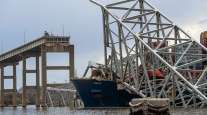Senior Reporter
Lawmakers, Administration Officials Tout Weather-Resilient Infrastructure

WASHINGTON — Last year’s destruction of critical infrastructure due to massive hurricanes and severe wildfires along the West Coast reinforces the long-term benefits of investing in resilient reconstruction efforts, a top Republican transportation authorizer in the House said July 18.
“Mitigation projects, particularly pre-disaster, are a wise investment of federal dollars and the only way we, as a nation, will be able to change the direction of rising disaster costs and losses,” said Rep. Lou Barletta (R-Pa.), chairman of the Economic Development, Public Buildings and Emergency Management Subcommittee. “It makes no sense for us to continue to rebuild the same way disaster after disaster.”
Studies from federal agencies, research institutions and industry stakeholders argue for utilizing resilient infrastructure when rebuilding communities and transportation corridors destroyed by extreme weather events, such as super hurricanes, Barletta explained. The chairman also emphasized that for every dollar of federal investment in mitigation, a return of $4 to $8 is realized.

Barletta
As Congress debates the merits of investing in mitigation, the panel’s ranking Democrat, Rep. Dina Titus of Nevada, reminded colleagues of the struggles residents of Puerto Rico and the U.S. Virgin Islands continue to endure. Both islands were hit hard by hurricanes last year. The collapse of critical freight corridors and power lines hindered the islands’ agriculture markets and vital tourism industries.
Since the start of hurricane season June 1, a hurricane downgraded to a tropical storm that struck Puerto Rico left more than 40,000 homes and businesses without power temporarily, Titus noted.
“In the midst of hurricane season, numerous homes in both Puerto Rico and the U.S. Virgin Islands still have blue plastic tarps as roofs due to damage caused by last year’s hurricanes. The intended lifespan of these tarps is 30 days,” Titus said.
Hurricanes that struck Texas and Florida also took out freight corridors, paralyzed commuter traffic for weeks, and damaged homes and warehouses. President Donald Trump congratulated his team’s response to the hurricanes.
Officials addressing the subcommittee about the Trump administration’s readiness for handling this year’s hurricane season agreed investing in resilient infrastructure is worthwhile.

Titus
“Building a nation of resilience, building a culture of resilience is one of the administrator’s top strategic goals,” said Jeffrey Byard, associate administrator at the Office of Response and Recovery with the Federal Emergency Management Agency.
“The Corps of Engineers certainly supports any effort to increase the resilience of the nation’s infrastructure and to promote life, health safety measures. We also support investments in mitigation, up front,” added Charles “Ray” Alexander, director of contingency operations and chief of the Office of Homeland Security at the U.S. Army Corps of Engineers.
David Paulison, former FEMA administrator under President George W. Bush, stressed to lawmakers the need is evident.
“You see that almost every agency that responds to disasters recognizes very clearly, very clearly, that pre-disaster mitigation works. It does save lives. It saves property,” Paulison said.
Besides hurricanes, last year the country dealt with vast wildfires in California, the Southwest and the Pacific Northwest, which disrupted transportation networks.
Tucked in a House-passed aviation policy bill is a measure designed to increase the federal emphasis on pre-disaster planning and mitigation. Its sponsors explained the measure’s aim is to increase safety and reduce the costs resulting from severe weather events.
Last year, Trump signed a $36.5 billion disaster relief package that included $18.7 billion for FEMA’s disaster relief fund, $16 billion for the national flood insurance program and $576.5 million to help West Coast communities with wildfires.




